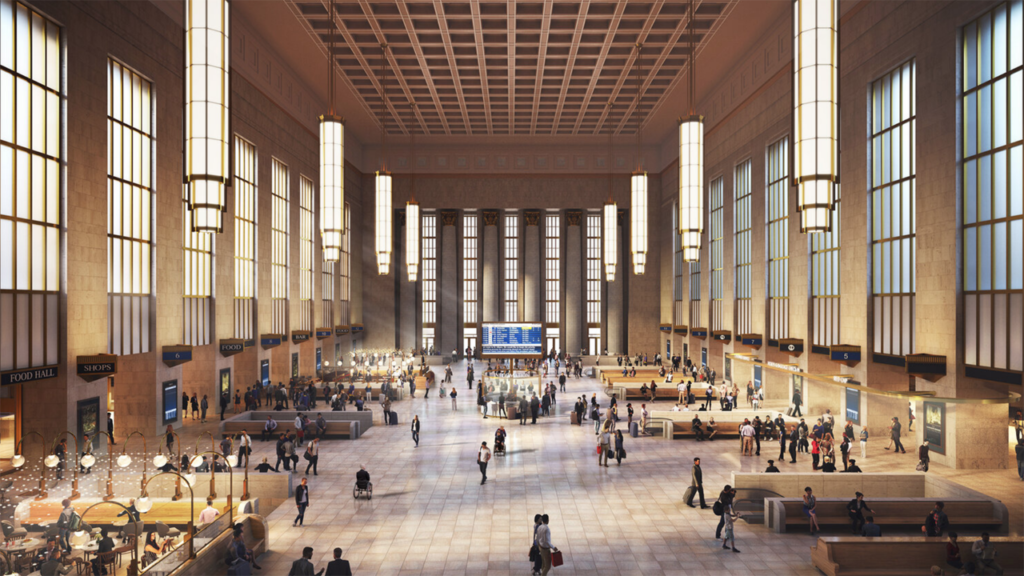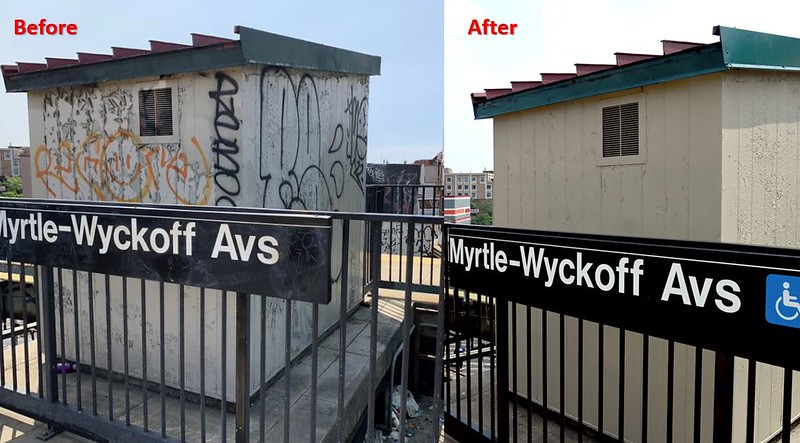
Transit Briefs: Amtrak, Caltrain, MTA Metro-North, NYMTA
Written by Carolina Worrell, Senior Editor
Amtrak has been honored on the Forbes Best Employers for New Graduates 2023 list.
Amtrak is honored on the Forbes Best Employers for New Graduates in 2023 list. Also, renovation work on Amtrak’s William H. Gray III 30th Street Station in Philadelphia is now under way; electric trains operated under power from the overhead contact system (OCS) run on Caltrain’s corridor for the first time; Connecticut’s new budget includes cutting a subsidy to the MTA Metro-North’s New Haven Line; and the New York Metropolitan Transportation Authority (MTA) completes renovation at Myrtle Ave-Wyckoff Ave subway station in Brooklyn.
Amtrak
Amtrak announced June 6 that, for the second year in a row, it has been honored on the Forbes Best Employers for New Graduates in 2023 list. The achievement, Amtrak says, come as the passenger rail service “builds a workforce to modernize infrastructure, major stations and trains and reach more of America.”
According to Amtrak, winners were selected from a survey of 28,000 young professionals. Participants were asked to rate employers in their respective industry and if they would recommend their employer to family and friends. They also assessed employers according to atmosphere, diversity, image, salary and working conditions.
Amtrak says its goal is to develop the next generation of talent through programs for paid internships and co-ops for both undergraduate and graduate students, as well as Apprenticeship Programs for those looking for entry-level learning opportunities. Amtrak also offers scholarships to students in trade, vocational and degree programs.
With a growing workforce of more than 20,000 employees, Amtrak says it has more than 4,000 positions to “support rebuilding rail infrastructure, improving current rail service and future growth.” Amtrak’s move to the future also includes acquiring new trains, station upgrades and accessibility improvements, major infrastructure projects and improved track capacity along the Northeast Corridor (NEC).
“We want to offer fulfilling experiences as we change how America moves,” said appointed Amtrak Executive Vice President and Chief Human Resource Officer Robert Grasty. “Creating thousands of new jobs to continue offering the service our customers have come to expect while advancing passenger rail, Amtrak is investing in railroad professionals as new graduates launch their careers.”

Separately, work has begun on a complete renovation and modernization of the recently renamed William H. Gray III 30th Street Station—in honor of the late Pennsylvania congressman—seen as a critical first step toward fulfilling the Philadelphia 30th Street Station District Plan, which was first unveiled in 2016, according to a Governing.com report.
Led by Amtrak, Brandywine Realty Trust, Drexel University, the Pennsylvania Department of Transportation (PennDOT) and the Southeastern Pennsylvania Transportation Authority (SEPTA), the plan is “a comprehensive vision for the future of the 30th Street Station District in the year 2050 and beyond.”
According to the Governing.com report, with $10 billion in public and private investment, the joint master plan “foresees an entirely new neighborhood of residential and commercial office towers, retail, cultural amenities and 40 acres of open public space, all of it built atop railyards and on land adjacent to the station.” In total the massive project could result in as much as 18 million square feet of new development. The district plan is expected to proceed incrementally over several decades, to be economically feasible.
Renovation work is now underway on the 90-year-old station, which is located in Philadelphia’s University City neighborhood and is Amtrak’s third busies, incorporating modern amenities and the improved operational efficiencies needed to handle a projected doubling of passenger volume over the next 25 years, according to the report.
“We’re taking a very sensitive approach as to how we chose materials for the new stuff,” says Gail Barman, Amtrak program manager for the Gray 30th Street Station redevelopment project. “Everything is intended to maintain the historic core and character of the building.” Work is expected to be completed by the end of 2026.
PIP, which selected by Amtrak in June 2020 through a competitive procurement, will refurbish and improve the historic, nearly 100-year-old building; finance those improvements; and maintain the station for a 50-year term, the railroad said. The project’s cost has been estimated between $300 million and $400 million.
Caltrain
The electrification of Caltrain has reached another major milestone as electric trains operated under power from the OCS for the first time, the agency reported on June 6.
According to Caltrain, initial tests will be conducted between Santa Clara and College Park stations on the Santa Clara Drill Track. Test runs will expand to the main track, between San Antonio and San Jose Diridon stations this summer.
“The start of testing for our new electric trains marks an historic moment for our agency, symbolizing tangible progress towards electrification” said Caltrain Executive Director Michelle Bouchard. “It signifies a future of improved service, reduced environmental impact and a more reliable experience that will benefit both our riders, and the communities that we serve.”
“Now that our new trains are running on our own power for the first time, it’s clear that the start of electrified service is just around the corner,” said Caltrain Board Chair Jeff Gee. “I couldn’t be more excited for our riders to experience the future of Caltrain next fall.”
Electric trains are quieter than the agency’s current diesel fleet, so Caltrain says the public is advised to pay close attention when crossing the tracks and to always wait for the gate to fully rise before crossing.
Caltrain’s historic Electrification Project is the first undertaking in North America in a generation in which diesel trains and their infrastructure components are transitioned to an electrified system.
The project, Caltrain says, will “improve the customer experience by increasing the number of trains, modernizing service and adding new safety elements.” The new trains will feature on board displays with digital trip information, increased storage capacities, baby-changing tables, Wi-Fi and power outlets at every seat.
Electrification, Caltrain adds, will also “help meet ambitious regional and state climate action goals by lowering greenhouse gas (GHG) emissions, improving air quality and relieving traffic congestion.” Additionally, electrified service will “advance equity along the corridor by reducing noise and air pollution while increasing access for priority equity communities. It will also set the framework for California’s future High Speed Rail network that will run on the Caltrain corridor,” the agency said.
MTA Metro-North
Connecticut’s recently approved $51.1 billion budget includes cutting a subsidy to MTA Metro-North’s New Haven Line by about $38 million in the first year to “reflect ridership decline on the commuter rail service,” according to a Yahoo! Finance report. Funding will be restored in the second year of the budget.
According to the report, the transit agency’s New Haven route is the busiest rail line for the MTA’s Metro-North Railroad, which connects Manhattan to its northern suburbs and transit officials have warned of possible service cuts, even during peak travel times. The MTA’s current budget includes a $267 million subsidy payment from Connecticut’s Department of Transportation (CTDOT) to help cover some of the costs for operating the line.
NYMTA
The New York MTA on June 6 announced that crews have completed cosmetic and functional renovations of the Myrtle Ave-Wyckoff Ave (M) subway station in Bushwick, Brooklyn, as part of NYCT’s Re-NEW-vation campaign to bring targeted resources to rebuild components of the station within a 55-hour window.

Over the last weekend while the station was closed to accommodate track replacement on the M line, transit workers installed new LED fixtures to brighten darkened areas, repaired concrete tripping hazards, cleaned service and emergency lighting, stripped and repainted surface areas, including ceilings and columns, restored benches, and replaced tiling along staircases. The station uplift also included refurbishment of transit employee breakrooms and restrooms within the station.
Myrtle Av-Wyckoff Av Station is the 31st station to be enhanced with an upcoming refurbishment planned at Kings Highway Station on the line. In total, NYCT plans to complete 50 “re-new-vations” by the end of the year.
“Re-New-Vation projects bring tangible and rapid improvements to stations in communities that can see the difference after a weekend of upgrades,” said NYCT President Richard Davey. “Following the completion of more than 30 re-new-vations, NYCT looks forward to continuing this initiative across the subway system.”
“I welcome the MTA’s forthcoming renovations to the Myrtle-Wyckoff Avenue M station, which, in addition to hosting a beloved public plaza, serves thousands of Brooklyn and Queens residents every day,” said Council Member Sandy Nurse. “The MTA’s Re-NEW-vation program will bring enhanced cleaning, repairs, and other much-needed upgrades to Myrtle-Wyckoff. We all deserve access to high quality, clean public transit stations and this initiative will help improve the quality of our subway system and ensure a clean, safe, and welcoming commute for our neighbors.”


